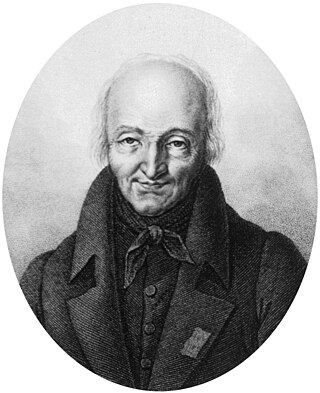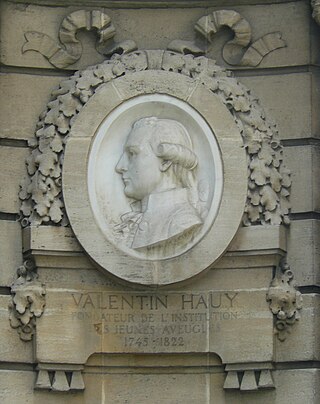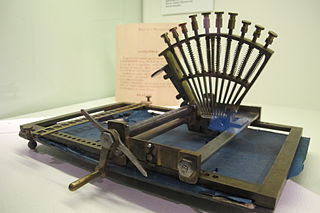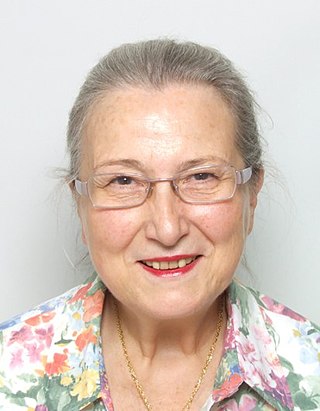
Louis Braille was a French educator and the inventor of a reading and writing system named after him, braille, intended for use by visually impaired people. His system is used worldwide and remains virtually unchanged to this day.

Duroc is a station on lines 10 and 13 of the Paris Métro. It is located at the point for which the 6th, 7th and 15th arrondissements share a common border, close to the location of an old toll gate on the road to Sèvres, part of the Wall of the Ferme générale, which was built around Paris between 1784 and 1791 by the ferme générale company of tax farmers. The station is named after the nearby rue Duroc, which in turn is named after Géraud Duroc, Duke of Frioul (1772–1813), who was one of Napoleon's generals, noted for his friendship with Napoleon Bonaparte, he is sometimes referred to as ‘Napoleon's shadow’.

The subject of blindness and education has included evolving approaches and public perceptions of how best to address the special needs of blind students. The practice of institutionalizing the blind in asylums has a history extending back over a thousand years, but it was not until the 18th century that authorities created schools for them where blind children, particularly those more privileged, were usually educated in such specialized settings. These institutions provided simple vocational and adaptive training, as well as grounding in academic subjects offered through alternative formats. Literature, for example, was being made available to blind students by way of embossed Roman letters.
Night writing is the name given to a form of tactile writing invented by Charles Barbier de la Serre (1767-1841). It is one of a dozen forms of alternative writing presented in a book published in 1815: Essai sur divers procédés d'expéditive française, contenant douze écritures différentes, avec une planche pour chaque procédé. The term does not appear in the book, but was later applied to the method shown on Plate VII of that book. This method of writing with raised dots that could be read by touch was adopted at the Institution Royale des Jeunes Aveugles in Paris.

René Just Haüy FRS MWS FRSE was a French priest and mineralogist, commonly styled the Abbé Haüy after he was made an honorary canon of Notre Dame. Due to his innovative work on crystal structure and his four-volume Traité de Minéralogie (1801), he is often referred to as the "Father of Modern Crystallography". During the French Revolution he also helped to establish the metric system.

Jacques Lusseyran was a French author and political activist. Blinded at the age of 7, at 17 Lusseyran became a leader in the French resistance against Nazi Germany's occupation of France in 1941. He was eventually sent to Buchenwald concentration camp because of his involvement, and was one of 990 of his group of 2000 inmates to survive. He wrote about his life, including his experience during the war, in his autobiography And There Was Light.

Charles Barbier de la Serre was the French inventor of several forms of shorthand and alternative means of writing, one of which became the inspiration for Braille.
Mélanie de Salignac (1741-1763) was a blind French musician whose achievements in the face of her disability were mentioned in the accounts of Diderot.

Jean-François Pierre Peyron was a French Neoclassical painter, printmaker, and art collector.

The Institut National des Jeunes Aveugles is a special school for blind students in Paris, France. It was the first school for the blind in the world, and served as a model for many subsequent schools for blind students.

The slate and stylus are tools used by blind people to write text that they can read without assistance. Invented by Charles Barbier as the tool for writing letters that could be read by touch, the slate and stylus allow for a quick, easy, convenient and constant method of making embossed printing for Braille character encoding. Prior methods of making raised printing for the blind required a movable type printing press.

The Musée Valentin Haüy is a private museum dedicated to tools and education of the blind, and located in the building of the Valentin Haüy Association, in the 7th arrondissement of Paris at 5, rue Duroc, Paris, France. It is open Tuesday and Wednesday afternoons without charge.
Maurice de La Sizeranne, blinded at age 9, was an important figure in the movement to support the blind.

Joséphine Pauline Boulay was a French organist, composer and professor.

The Quinze-Vingts National Ophthalmology Hospital is France's national ophthalmology hospital located in Paris, in the 12th arrondissement. The hospital gave its name to the Quinze-Vingts quarter.
Sophie Massieu, is a journalist from the department of Manche in Normandy, France.
Catherine J. Kudlick is an American historian. She is a Professor of History and director of the Paul K. Longmore Institute on Disability at San Francisco State University. She is also an affiliated professor in the Laboratory ICT University Paris VII.
Marius André Gueit was a 19th-century French organist, cellist and composer.

Pierre-François-Victor Foucault (1797–1871) was the inventor in 1843 of the first printing machine for braille, the decapoint.

Zina Weygand is a French historian and emeritus researcher at the Conservatoire national des arts et métiers. She obtained her PhD from University Paris 1 in 1998.
















